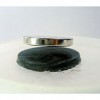Magnet Experiments: Magnetic Levitation of a Superconductor
In a previous blog we discussed and conducted an experiment showing diamagnetic levitation, the phenomenon that happens when diamagnetic materials levitate in between an arranged magnetic field. In this blog, we’re discussing superconducting levitation with magnets. Superconducting levitation, also known as the Meissner effect, can be considered a “super” form of diamagnetic levitation. A superconducting material like Yttrium-barium-copper-oxide enters a state of zero electrical resistance when it reaches its superconducting point. This state seems to defy gravity by repelling magnetic fields and levitating. In this example, the temperature needed to become a superconductor with perfect diamagnetism is around 93 Kelvin or -180° Celsius.
Since this experiment requires liquid nitrogen in order for the superconductors to reach an extremely low temperature, it is meant for adults only and should be conducted in a laboratory or other controlled setting with professionals.
Supplies
- Superconducting material (YBCO disc)
- Neodymium magnets
- Liquid nitrogen
- Safety gear (goggles and insulated gloves)
- Plastic tongs
- Styrofoam cup or plastic petri dish
Steps
- If you are using a styrofoam cup, cut the bottom of it so that is similar to the size of a petri dish. If you have a plastic petri dish you can use that instead.
- Put on your insulated gloves and goggles. You must wear safety gear for this experiment. Liquid nitrogen can cause severe burning to exposed skin.
- Pour about ¼ inch of liquid nitrogen into your makeshift dish then carefully seal the liquid nitrogen container.
- If the liquid nitrogen is boiling, wait for it to stop. Using the plastic tongs place the YBCO disc inside the dish.
- With the tongs, place the neodymium magnet above the dish and watch the magnet levitate above it even after you have let it go.

